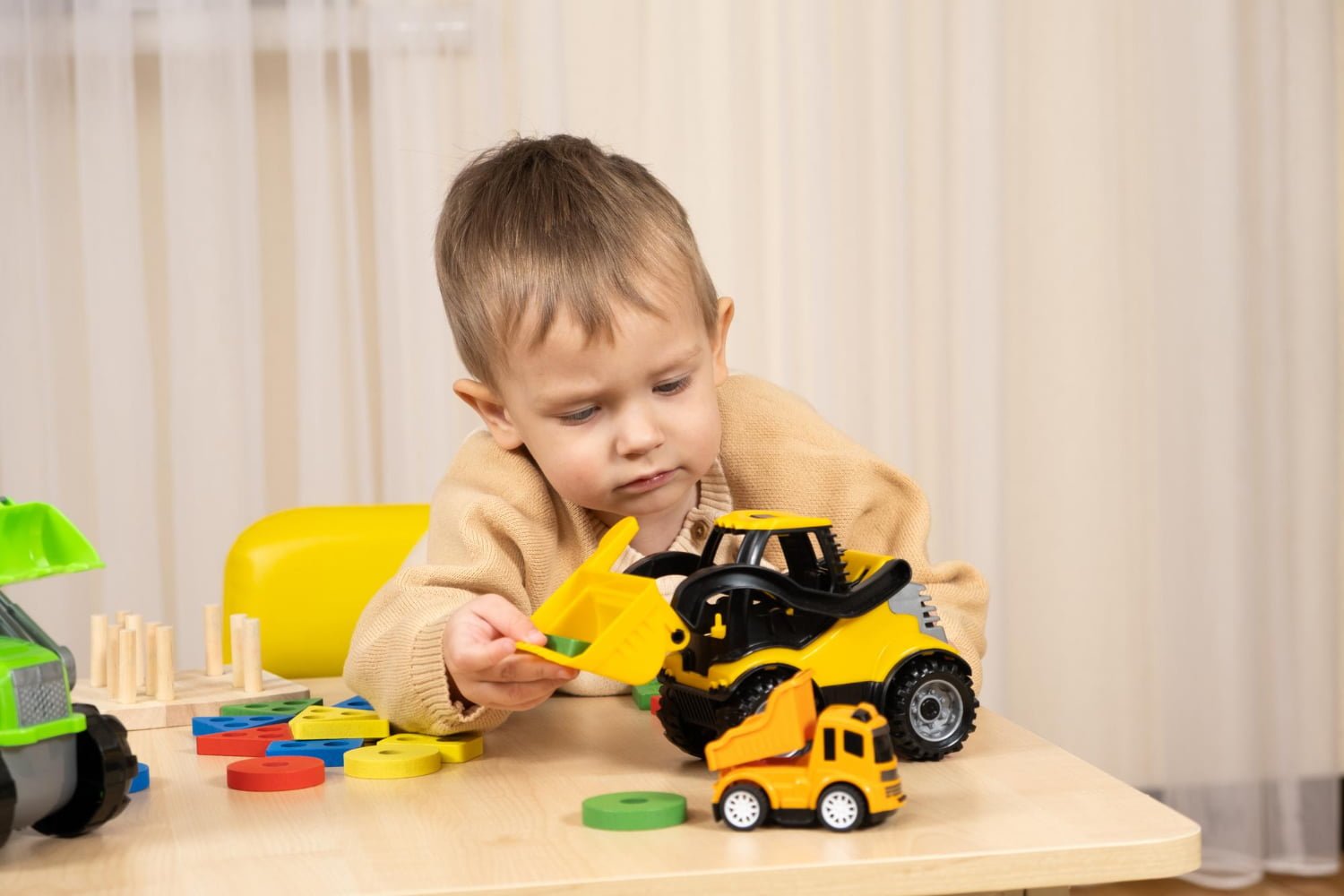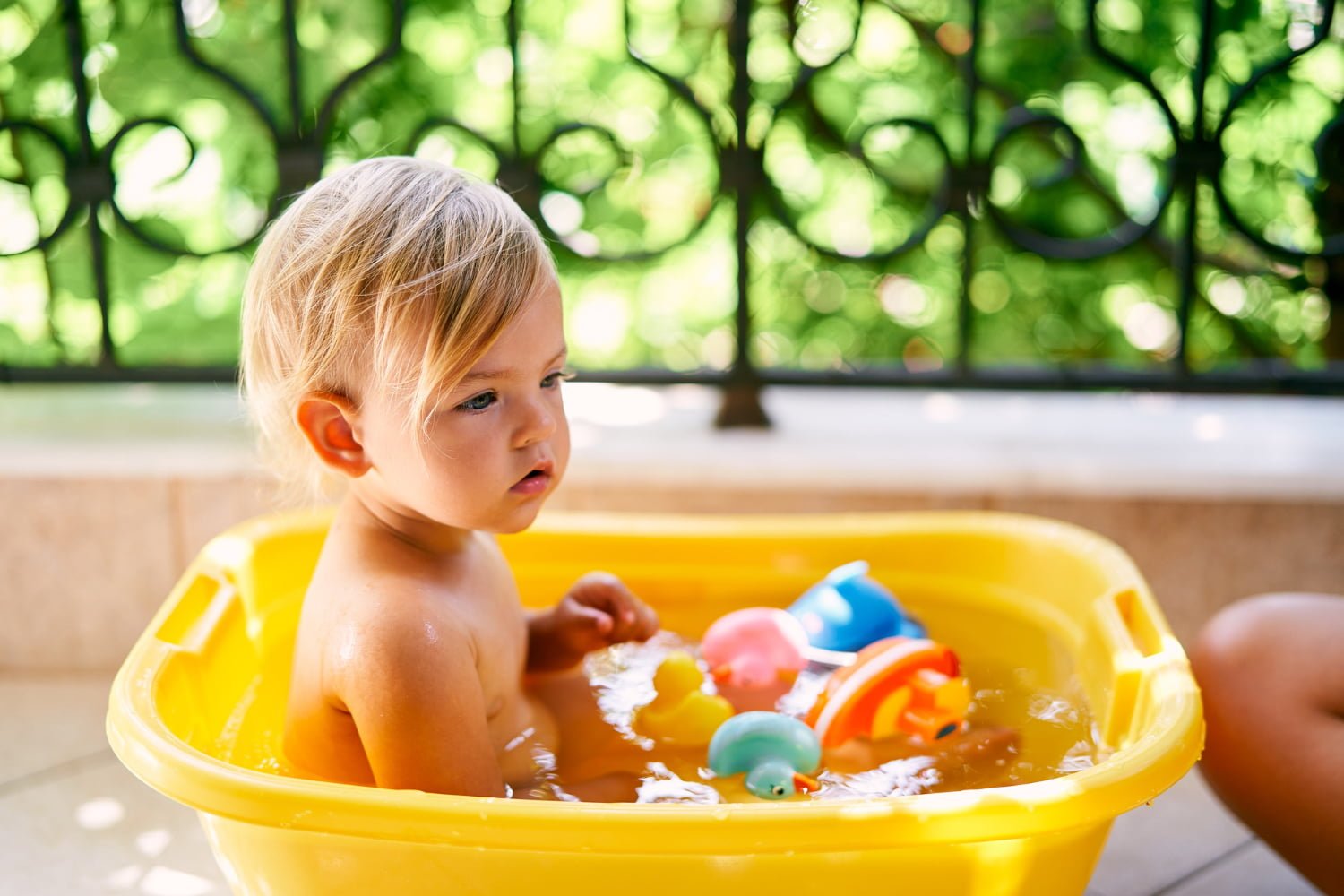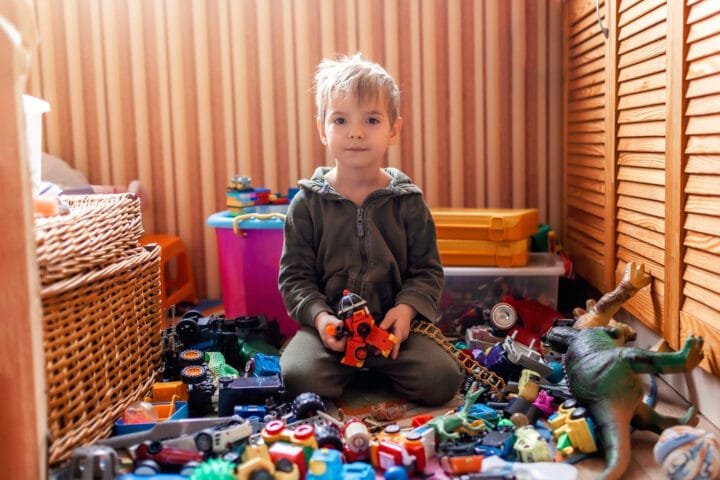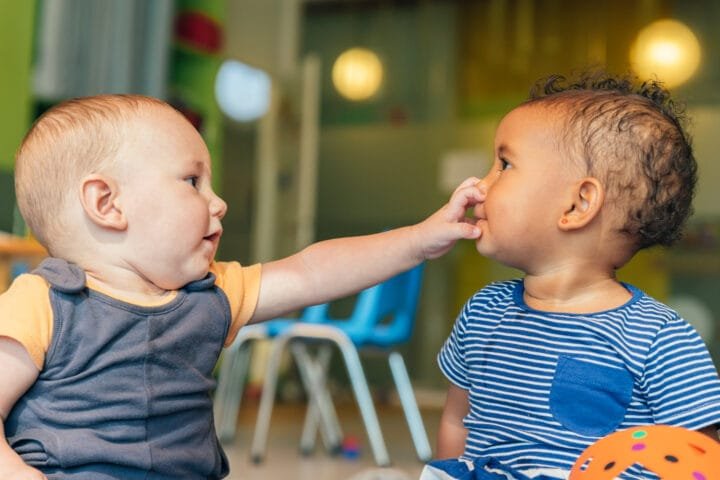Don’t Buy Another Toy Until You Read These Lists of Toys That Are Not Safe for Toddlers!
Playtime recalls bright colors, joyful laughter, and a toddler immersed in their world. Play is essential for our children. It’s the engine of their development, learning, growing, exploring, and figuring out how this wild world works. Through play, they build their imaginations, hone their problem-solving skills, and develop those crucial social-emotional muscles they’ll need throughout life. But – and this is a big “but” – this age of wonder and exploration is also fraught with hidden dangers. As parents, we find ourselves walking a tightrope, balancing the vital need for free, imaginative play with the equally pressing need to keep our children safe. It is like an extreme sport!
While we diligently baby-proof our homes, covering every sharp corner, locking every cabinet, and gating every staircase, we often overlook the potential hazards lurking within the things designed to bring our children joy: their toys. We must ask ourselves. Are we doing enough? This guide covers toy safety, helping you confidently navigate the toy aisle.
Why Toddlers Are Tiny, Adorable Daredevils
Let’s be honest: toddlers are tiny, adorable daredevils with an incredible knack for getting into trouble. Their natural curiosity, along with their developmental stage, makes them especially vulnerable. They have an insatiable desire to explore every nook and cranny of their environment, primarily through touch—and, let’s face it, taste. It seems like everything must go into their mouths!
Between the ages of 1 and 3, they’re mastering a whole new set of skills. Their tiny hands are learning to grasp, pull, poke, and, unfortunately, put things in their mouths that don’t belong there. Their fine motor skills are still developing, so they’re often clumsy, prone to dropping things, and generally a bit like adorable little bulls in a china shop.
Toddlers are in a developmental stage where their physical abilities often surpass their understanding of potential risks, says Dr. Sarah Klein, a developmental pediatrician with over 20 years of experience. They are active and curious but cannot yet recognize danger like older children or adults.
It’s not just their physical development, either. Their brains are still under construction. They’re learning about cause and effect but don’t fully grasp the concept. They don’t understand that swallowing that shiny button could hurt them. It’s a constant battle of wits. We’re trying to keep them safe. They’re trying to explore at any cost!
This Guide: Your Secret Weapon in the Toy Safety Battle
Use this guide as your go-to resource for keeping your toddler safe in the playroom. We will cover toy hazards, from choking risks to hidden dangers from toxic materials. We’ll talk about specific things to watch out for, like those dreaded button batteries (shudder) and those surprisingly strong magnets that can wreak havoc on little tummies.
But this isn’t just about scaring you with a laundry list of potential dangers. It’s about empowering you with knowledge. It’s about understanding the “why” behind the risks so you can make informed decisions and create a play environment where your little explorer can thrive safely.
Choking Hazards: The Silent Threat Lurking in the Toy Box
Choking. The word itself sends shivers down any parent’s spine. Choking is a serious risk for toddlers, transforming moments of fun into life-threatening situations. With small airways, developing swallowing reflexes, and a tendency to put objects in their mouths, the danger they face is real and immediate.
The Grim Reality: Choking Statistics Paint a Sobering Picture
The statistics surrounding choking in young children are stark and, frankly, heartbreaking. According to the Centers for Disease Control and Prevention (CDC), choking is a leading cause of injury and death among children, particularly those under the age of 3.
- A child dies every five days in the United States from choking. This chilling statistic from the National Safety Council underscores the urgency of this issue.
- The American Academy of Pediatrics (AAP) reports that emergency departments treat thousands of children each year for choking-related incidents. Many incidents involve toys or small parts lodged in a child’s airway.
Dr. Gary Smith, Director of the Center for Injury Research and Policy at Nationwide Children’s Hospital, notes that most choking incidents in young children are preventable. Parents can significantly reduce the risk by understanding these dangers and taking proactive measures.
It’s not just about the immediate, life-threatening danger, either. Even if a child survives a choking incident, a lack of oxygen to the brain can cause long-term damage, impacting cognitive function, motor skills, and overall development.
Toys with Detachable Parts: An Accident Waiting to Happen
Think about those seemingly innocent toys with small, detachable parts. The cute stuffed animal with button eyes that can be popped off. The building is set with tiny pieces just the right size to be swallowed. These toys might look harmless on the shelf, but in toddlers’ hands (and mouths), they can be incredibly dangerous.
It is important to remember that a toddler’s natural exploration often involves pulling things apart. No matter how big the toy is, it could be a choking hazard if any part can detach.
Beyond Toys: The Everyday Objects That Become Choking Hazards
The danger doesn’t stop with toys, though. Everyday household items can also pose a significant choking risk to toddlers. We’re talking about things like:
- Coins: Loose change left on a table or in a pocket is an irresistible temptation for a curious toddler.
- Marbles: Their smooth, round shape makes them easy to swallow but challenging to dislodge.
- Button Batteries: These small, shiny discs are found in many household devices and are extremely dangerous if swallowed.
- Food Items: Grapes, hot dogs, nuts, and hard candies are common choking hazards due to their size and shape.
“Parents often underestimate the choking risk posed by everyday objects,” warns Dr. Klein. “It’s crucial to be vigilant not only about the toys you choose but also about the environment your child is playing in.”
The Toilet Paper Roll Test: Your Simple, Yet Effective, Safety Check
Here’s a simple yet incredibly effective trick to help you assess whether an object poses a choking hazard: the toilet paper roll test. If an object can fit entirely through a standard toilet paper roll (roughly 1.75 inches in diameter), it’s too small for a toddler and presents a choking risk.
You can also purchase a “small parts tester,” a small tube designed to mimic a child’s airway size. These are readily available online or in baby stores. It is a good idea to have one on hand.
Regularly inspect toys by feeling for loose parts. Gently tug on eyes, buttons, and minor components to ensure they are secure. Discard any items that seem unsafe—it’s better to be cautious.
What to Do If Your Toddler Is Choking: Seconds Count
Knowing what to do if your child is choking is critical. It could mean the difference between life and death. Time is of the essence in a choking emergency and acting quickly and calmly can save your child’s life.
- Encourage Coughing: If your child is coughing forcefully, encourage them to continue. Coughing is the body’s natural way of clearing the airway, which may be enough to dislodge the object.
- Heimlich Maneuver (for children over one-year-old): If your child cannot breathe, cry, or talk, they need immediate intervention. The Heimlich maneuver, which involves performing abdominal thrusts, is recommended for children over one year old.
- Back Blows and Chest Thrusts (for infants under one year old): A combination of back blows and chest thrusts is recommended for infants under one year old.
Get Trained: It’s crucial to familiarize yourself with these life-saving techniques. A certified first-aid and CPR course that includes infant and child choking training is highly recommended. These courses provide hands-on practice and can significantly boost your confidence in handling such emergencies. Many hospitals, community centers, and organizations like the American Red Cross offer these courses. Knowing these skills can make all the difference in the world.
Toxicity Troubles: The Hidden Dangers Lurking Within
We’ve covered the immediate and terrifying threat of choking, but there’s another, more insidious danger lurking within many toys: toxic materials. These toxins might not cause immediate harm, but prolonged exposure can have serious, long-lasting consequences for a child’s health and development.
Lead Paint: A Persistent and Potentially Devastating Threat
Lead paint is a significant concern, particularly in older toys or those manufactured in countries with lax safety standards. While lead paint in toys has been banned in the United States since 1978, it can still be found in some imported toys, vintage items, and even painted surfaces in older homes.
Exposure to lead, even at low levels, can have devastating effects on a child’s developing brain and nervous system. It can cause:
- Developmental Delays: Lead can interfere with a child’s cognitive development, leading to delays in speech, language, and motor skills.
- Learning Disabilities: Children exposed to lead often experience difficulties in school, including problems with attention, memory, and problem-solving.
- Behavioral Problems: Lead exposure has been linked to an increased risk of behavioral issues, such as impulsivity, aggression, and hyperactivity.
- Lower IQ: Studies have shown a direct correlation between lead exposure and lower IQ scores in children.
- Other Health Problems: Lead can also damage other organs in the body, including the kidneys and the reproductive system.
“The effects of lead poisoning can be permanent and irreversible,” warns Dr. Maria Hernandez, a toxicologist specializing in environmental health. “Even small amounts of lead can significantly impact a child’s developing brain.”
The CDC estimates that at least 4 million households in the U.S. have children living in them that are being exposed to high levels of lead. There is no safe blood lead level in children.
Phthalates and BPA: The Plasticizers You Need to Know About
Phthalates and Bisphenol A (BPA) are chemicals commonly used to produce plastics to make them more flexible and durable. They’re found in various toys, from soft plastic dolls to bath toys to teething rings.
Unfortunately, these chemicals have been linked to a range of health concerns, including:
- Hormone Disruption: Phthalates and BPA are known endocrine disruptors, meaning they can interfere with the body’s hormonal system. This can lead to problems with development, reproduction, and metabolism.
- Reproductive Problems: Studies have linked exposure to these chemicals to reproductive issues, such as early puberty in girls and decreased sperm count in males.
- Other Health Issues: Research suggests a possible link between phthalate and BPA exposure and other health problems, such as asthma, obesity, and certain types of cancer.
“The science on phthalates and BPA is still evolving, but there is growing evidence that these chemicals can have adverse effects on human health, particularly in children,” says Dr. Hernandez.
Becoming a Label Detective: Navigating the Murky Waters of Toy Safety Standards
When choosing safe toys, it’s not just about avoiding the bad stuff but also about seeking the good. Become a label detective! Look for toys that are clearly labeled as:
- “BPA-free” indicates that the product does not contain Bisphenol A.
- “Phthalate-free”: This label signifies that the toy is free from phthalates.
- “Lead-free”: This means that the toy does not contain lead.
The ASTM F963 label is another important one to look for. This indicates that the toy meets the U.S. safety standards for various hazards, including chemical content.
However, don’t rely solely on labels. Do your research! Investigate the manufacturer’s reputation. Look for online reviews from other parents. See if there have been any reports of safety issues or recalls. It might seem like a lot of extra work, but it’s worth it for your child’s health and well-being.
Natural Toys: A Safer Alternative, But Not Always a Guarantee
Natural toys, made from wood, organic cotton, or wool, are often touted as a safer alternative to plastic toys. And in many cases, they are. They often contain fewer harmful chemicals and can be more durable and sustainable.
However, “natural” doesn’t always equate to “safe.” It’s important to remember that even natural materials can be treated with harmful chemicals. For example:
- Wooden toys: Make sure they are made with non-toxic paints and finishes. Some wood stains and sealants can contain volatile organic compounds (VOCs) that can be harmful if inhaled or ingested. Look for certifications like the Forest Stewardship Council (FSC) label, which indicates that the wood comes from responsibly managed forests.
- Fabric toys: Opt for organic cotton or wool whenever possible. Conventional cotton is often grown with pesticides that can leave harmful residues on the fabric.
Even with natural toys, it’s still crucial to do your research. Investigate the brands, read reviews from other parents, and don’t be afraid to ask questions.
Physical Hazards: Beyond Choking and Toxins
We’ve covered the significant concerns of choking and toxic materials, but other physical hazards can lurk in the toy box. These might seem less insidious, but they can still cause serious injuries.
Sharp Edges and Points: Ouch!
Toddlers are notorious for their falls and bumps as they navigate the world around them. It’s all part of the learning process. But toys with sharp edges or points can turn a minor tumble into a trip to the emergency room.
Scrutinize toys for sharp edges, rough surfaces, or protruding parts. Run your fingers along the edges, feel for any roughness, and don’t hesitate to return or discard anything that seems questionable.
Projectile Toys: Fun with a Side of Risk
Toys that shoot or launch objects can be a lot of fun but can also be dangerous, especially for toddlers. A projectile, whether a foam dart, a small ball, or a water balloon, can cause eye injuries or even become a choking hazard if swallowed.
“Projectile toys can be particularly hazardous for young children due to their lack of coordination and tendency to put things in their mouths,” cautions Dr. Klein.
If you allow your toddler to play with projectile toys, supervise them closely. Ensure they’re using them safely and understand not to aim at anyone’s face, especially their own. Choose age-appropriate toys with soft projectiles, and always ensure they are large enough not to be a choking hazard.
Ride-On Toys: Wheely Fun, But Watch Out for Tumbles
Ride-on toys, from rocking horses to tricycles, offer toddlers freedom and independence. They’re fantastic for developing gross motor skills and balance. However, they can also be unstable, especially for toddlers still mastering their coordination.
- Choose wisely: Select ride-on toys that are low to the ground and have a broad, stable base. Please ensure they are appropriate for your child’s age, size, and developmental stage.
- Helmet, always! Insist that your child wears a helmet every time they use a ride-on toy, even if it’s just for a short ride in the living room. It might seem overkill, but it can make all the difference in preventing a head injury.
- Supervision is key: Always supervise your child using a ride-on toy, especially outdoors or near stairs.
Cords, Strings, and the Silent Threat of Strangulation
Toys with long cords or strings might seem harmless, but they can pose a serious strangulation hazard, especially for babies and young toddlers. A curious toddler can quickly become entangled in a cord, and the consequences can be tragic.
- Keep it short: Never let a child under three plays with toys with strings or cords over 12 inches.
- Crib and playpen safety: Keep toys with strings or cords far away from cribs and playpens, where a child could become entangled while unsupervised.
- Beyond toys: Be mindful of other potential strangulation hazards in your home, such as window blind cords and loose electrical wires.
The Hidden Dangers: Emerging Threats You Need to Know About
New ones emerge when you think you’ve got a handle on all the potential toy hazards. Staying informed about these hidden dangers is crucial for protecting your child.
Button Batteries: Small, Shiny, and Incredibly Dangerous
Button batteries, those small, shiny, disc-shaped batteries found in many toys, remote controls, and other electronic devices, are a growing concern. They might look innocuous, but if swallowed, they can cause severe, even fatal, injuries within a matter of hours.
When a button battery gets lodged in a child’s esophagus, it can create an electrical current that burns through the surrounding tissue. This can lead to:
- Severe tissue damage: The electrical current can cause severe burns and perforations in the esophagus, stomach, or intestines.
- Internal bleeding: The burns can damage blood vessels, leading to internal bleeding.
- Infection: The damaged tissue is susceptible to disease, further complicating the situation.
- Death: In the most severe cases, button battery ingestion can be fatal.
“Button batteries are hazardous because they can cause significant damage very quickly,” warns Dr. Hernandez. “If you even suspect that your child has swallowed a button battery, seek medical help immediately. This is a true emergency.”
Statistics on Button Battery Ingestion:
- More than 2,800 children are treated in emergency rooms each year after swallowing button batteries. This translates to one child every three hours.
- The number of serious injuries or deaths related to button batteries has increased nine-fold in the last decade. This alarming trend highlights the growing danger posed by these tiny power sources.
What to do if you suspect your child swallowed a button battery:
- Go to the emergency room immediately. Do not wait to see if symptoms develop.
- Do not induce vomiting. This can worsen the damage.
- Do not give the child anything to eat or drink.
- Bring the battery to the emergency room if possible. This can help the medical team identify the type of battery and determine the best course of treatment.
Prevention is key:
- Secure battery compartments: Make sure that the battery compartments on all toys and devices are securely closed and cannot be easily opened by a child. Use strong tape if needed.
- Keep loose batteries out of reach: Store loose batteries in a locked container, far from the reach of children.
- Dispose of old batteries properly: Recycle used button batteries at designated collection points.
- Educate older children: Teach older children about the dangers of button batteries and instruct them to keep them away from younger siblings.
Magnets: The Attraction Can Be Deadly
High-powered magnets, like those found in some building sets, desk toys, and even some fidget toys, might seem harmless fun, but they can cause severe internal injuries if swallowed. The problem arises when two or more magnets are ingested.
Here’s why:
When multiple magnets are swallowed, they can attract each other inside the body, even across different digestive tract sections. This attraction can pinch or trap intestinal tissue between the magnets, leading to the following:
- Perforations: The pressure from the magnets can create holes in the intestinal walls.
- Blockages: The trapped tissue can obstruct the digestive tract, preventing food from passing through.
- Infections: Perforations and blockages can lead to serious infections.
- Tissue death: The trapped tissue can lose its blood supply and die.
- Death: In severe cases, magnet ingestion can be fatal.
“The injuries caused by swallowing multiple magnets can be severe and often require surgery to repair,” explains Dr. Smith. “These magnets are not your typical refrigerator; they are significantly stronger and pose a much greater risk.”
Statistics on Magnet Ingestion:
- The CPSC has received hundreds of reports of incidents involving magnet ingestion. Many of these cases required surgery to remove the magnets and repair the damage to the intestines.
- Emergency room visits for magnet ingestions have increased dramatically in recent years. This rise is likely due to the increasing popularity of high-powered magnet sets.
What to do if you suspect your child swallowed magnets:
- Go to the emergency room immediately. Do not wait to see if symptoms develop.
- Do not induce vomiting.
- Do not give the child anything to eat or drink.
- Bring the packaging or any remaining magnets to the emergency room if possible. This can help the medical team assess the situation.
Keeping magnets away from toddlers:
- Avoid purchasing high-powered magnet sets for your home if you have young children. These sets are inappropriate for toddlers and should be kept out of their reach.
- Supervise older children closely when they are playing with magnets. Ensure they understand the dangers and do not put the magnets in their mouths or near younger siblings.
- Store magnets securely: Keep magnets in a locked container that is out of reach of children.
Loud Toys: The Noise That Can Damage Delicate Ears
We often associate noisy toys with fun and excitement, but some toys are so loud that they can damage a toddler’s developing hearing. Prolonged exposure to loud noises can lead to noise-induced hearing loss, an irreversible condition.
“Children’s ears are particularly vulnerable to noise damage,” explains Dr. Klein. “Their auditory systems are still developing, and their ear canals are smaller, which means that sounds are amplified more than in adults.”
How loud is too loud?
- The CDC recommends that children’s toys not produce sounds louder than 85 decibels. In perspective, a normal conversation is about 60 decibels, while a lawnmower is around 90 decibels.
- If a toy seems too loud to you, it’s too noisy for your toddler. Trust your instincts.
- Limit exposure: Even if a toy is within the recommended decibel range, limiting your child’s exposure to loud noises is still a good idea.
Protecting your child’s hearing:
- Choose quieter toys: Opt for toys that don’t rely on loud noise for their entertainment value.
- Turn down the volume: If a toy has a volume control, turn it down to the lowest setting.
- Take breaks: Encourage your child to take breaks from playing with noisy toys.
- Be mindful of other noise sources: Limit your child’s exposure to other loud noises, such as loud music, television, and noisy environments.
Staying Informed: Your Ongoing Mission
The world of toy safety is constantly evolving. New toys are introduced, new hazards are identified, and safety standards are updated. Staying informed is an ongoing process, but it’s one of the most important things you can do to protect your child.
Recalls: Your First Line of Defense
Toy recalls happen more often than you might think. Manufacturers or the CPSC may issue a recall if a toy is found to be defective or poses a safety hazard. Staying up-to-date on recalls is crucial.
- The CPSC website (www.cpsc.gov): This resource provides a database of recalled products. You can search by product type, company, or hazard.
- Sign up for email alerts: The CPSC allows you to sign up for email alerts to be notified of new recalls as soon as they are issued.
- Other organizations: Organizations like the American Academy of Pediatrics (www.aap.org) and Kids In Danger (www.kidsindanger.org) also provide information on toy recalls and safety.
Resources to Empower You:
- The Consumer Product Safety Commission (CPSC): www.cpsc.gov – Your go-to source for information on product recalls, safety standards, and other safety-related issues.
- The American Academy of Pediatrics (AAP): www.aap.org – Offers information on child health and safety, including toy safety tips and guidance.
- Kids In Danger (KID): www.kidsindanger.org – A nonprofit organization dedicated to protecting children by improving children’s product safety. They provide information on recalls, advocate for more substantial safety standards, and offer resources for parents.
- The National Safety Council (NSC): www.nsc.org – A leading safety advocate, providing resources and information on various safety topics, including child safety.
The Final Word: Creating a Safe and Joyful Play Space
Play is vital for a child’s development, enabling them to learn and explore. However, safety must always come first. As parents, we must create a fun and secure play environment. Understanding toy safety is essential; by knowing potential hazards, you can make better choices for your child. A safe play area allows your child to thrive and discover without risks.
It’s about balancing fun and safety. Create a space where your child can be themselves, take risks, make mistakes, and learn—all while being protected by your care. Let’s move forward with knowledge and a strong commitment to toy safety. Together, we can ensure our children can play freely without fearing hidden dangers. Their safety and happiness are our top priorities. Their joyful play is advantageous, and it is worth it!
FAQs
That’s a question many parents ask, and it’s understandable! While many manufacturers prioritize safety, the sheer volume of toys produced and the constant drive for new and exciting features can sometimes lead to oversights. Toddlers are at a unique developmental stage where they explore the world through touch and taste, and their small airways make them especially vulnerable to choking hazards. Also, regulations can lag behind new toy trends. Some toys use small parts, which the regulations don’t keep up with. Parents must be vigilant and informed about potential risks, even with safe toys on the shelf. We will help you stay informed. This is not to say that manufacturers are malicious; regulations are constantly being updated.
Lists of unsafe toys for toddlers can be invaluable, but knowing where they come from is essential to gauge their reliability. Reputable lists are typically compiled by organizations like the Consumer Product Safety Commission (CPSC), the American Academy of Pediatrics (AAP), and other child safety advocacy groups. These organizations base their lists on reported incidents, product testing, and expert analysis of potential hazards. They often look at choking risks, toxic materials, and design flaws. However, no list can be completely exhaustive, and new hazards can emerge. So, consider these lists as a starting point for your research, and always use your best judgment. It is a good idea to cross-reference a few lists to ensure you have the most information.
It’s a constant challenge. Toddlers explore the world orally, a natural part of their development. While you can’t completely prevent them from putting things in their mouths, you can create a safer environment. First, choose toys specifically designed for toddlers that meet safety standards. Second, toys should be regularly inspected for loose parts or damage. Get down to their level and look for small objects that might have fallen on the floor. Third, the “toilet paper roll test” is a great tool – if a toy or part can fit through a toilet paper roll, it’s a potential choking hazard. Supervision is key, especially during playtime. Most importantly, you are aware and take steps to keep your toddler safe.
It’s easy to assume that “natural” equals “safe,” but unfortunately, that’s not always true. While wooden toys, for example, can be a great alternative to plastic, ensuring they’re made with non-toxic paints, finishes, and glues is essential. Some wood stains and sealants can contain harmful chemicals. Look for the Forest Stewardship Council (FSC) label to ensure the wood comes from responsibly managed forests. Always check for splinters and rough edges. Choose reputable brands that prioritize safety and avoid harmful finishes or stains.
Choosing toys for your child is an exciting opportunity to foster their growth and happiness! Instead of picking the first bright option, take a moment to read the labels, consider age recommendations, and assess safety features. Trust your instincts; if something feels off, it’s wise to be cautious. Your thoughtful choices will ensure your child’s playtime is both safe and joyful, making every moment memorable!
Recommend Books
“Baby Bargains: Secrets to Saving 20% to 50% on Baby Furniture, Equipment, Clothes, Toys, Maternity Wear, and Much, Much More!” by Denise Fields and Alan Fields
While not solely focused on toy safety, this book is a comprehensive guide to navigating the world of baby products, including toys. It provides valuable tips on choosing safe and reliable brands, understanding safety standards, and avoiding marketing hype. It includes an entire section on toy safety. The book is regularly updated, which makes it great to keep up with recalls.
“Raising a Healthy, Happy Eater: A Parent’s Handbook: A Stage-by-Stage Guide to Setting Your Child on the Path to Adventurous Eating” by Nimali Fernando
This book is about food and keeping toddlers safe from choking hazards. It gives important information on the right food sizes, textures, and how to prepare food to lower the risk of choking. The book also explains key stages in a child’s eating development, which helps parents feel confident when introducing new foods. This guide helps parents know when their child is ready for different foods, ensuring safer eating.
“Retro Baby: Cut Back on All the Gear and Boost Your Baby’s Development with More Than 100 Time-Tested Activities” by Anne H. Zachry
This book focuses on the importance of simple play that is appropriate for children’s development. It encourages using everyday objects instead of fancy toys. While not strictly a toy safety book, it implicitly promotes safer choices by encouraging natural play patterns and reducing reliance on potentially hazardous electronic or overly complex toys. This book goes into how simple toys are better for development. This is important to keep in mind when thinking about toy safety.
“What to Expect the Second Year: From 12 to 24 Months” by Heidi Murkoff
This trusted resource, part of the “What to Expect” series, provides information on toddler development, including a dedicated section on toy safety. It covers age-appropriate toy selection, common hazards to avoid, and tips for creating a safe play environment. This book is excellent because it gives a detailed guide on what to expect from your child from 12-24 months. It covers everything from milestones to safety.












































































